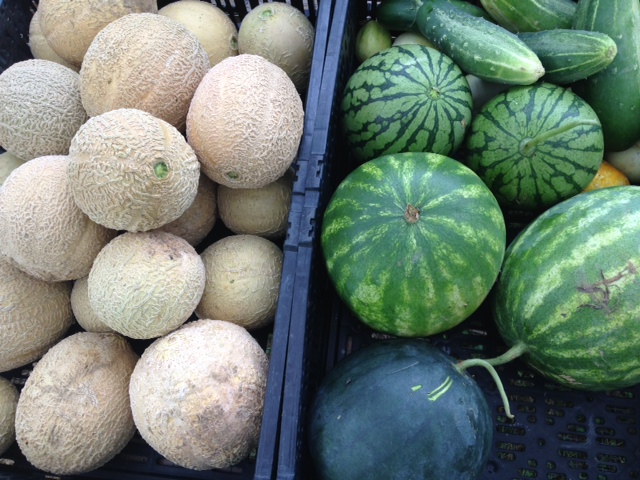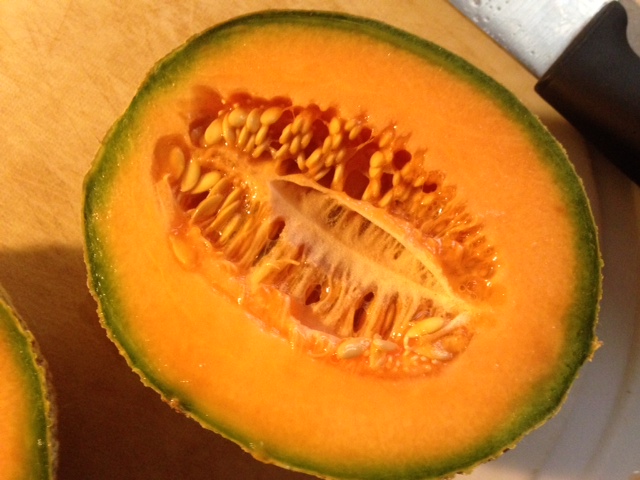With only two days of August left, we have entered a new phase at the farm: bulk harvesting. To this point in the season, everything that we bring to the market has been picked fresh with the exception of potatoes, which we normally dig less than a week before the market, wash, dry, and let cure for 1-3 days. Today, things changed. We began harvesting our winter squash (pie pumpkins, butternut, delicata, and acorn squash), which we will now let cure before we begin bringing them to the market. Next up will be storage onions, which also need time to cure before they can come to the market. Before too long, we will have beans to pick, dry, shell, and store. Then come sweet potatoes and two varieties of potato that we still have left out in the field.
Storage vegetables all require different conditions for curing, which is the process of toughening up the skin so the vegetables aren’t susceptible to invasion by rotting organisms like mold, fungus, and bacteria. After the vegetables have cured, they want different conditions for storage so they remain in a stable condition until you’re ready to eat them. Curing and storing vegetables can be tricky, especially if you don’t have large, well-ventilated climate controlled areas, so a new farmer like me has to make the best use of the spaces that we’ve got. Winter squash, once they are picked ripe off of their vine, want to sit in a well-ventilated area that is warm (70-80 degrees F). This allows the stem of the squash to dry up and the skin to thicken, creating a nice sealed exterior impenetrable to rot organisms. If the squash isn’t nicked or bruised, it can survive a very long time, sometimes all through the winter and into the spring! I don’t have a space right now that can provide these conditions for hundreds of pounds of winter squash, so my best alternative is to put them in a greenhouse. While the greenhouse is currently hotter and not as well-ventilated as I’d like, the winter squash will at least be dry, warm, and elevated off the ground. Elevation is important for air circulation and for keeping the squash a little bit out of the way of bugs and rodents that would like to eat them.


I could have allowed my winter squash to continue sitting in the field on their vines and let them cure out in the open air. With lots of hot, wet days in the forecast, however, I didn’t want to run the risk of having my squash rot, especially because most of their vines have died back and therefore aren’t providing the life support the squash need to fight off the agents of rot. Also, as the squash sit in the field, their starches convert to sugars and they become more delectable to the palates of deer and other vermin. So, I decided that it was finally time to get the winter squash up and out of the field. Now we can cut down the forest of weeds that have grown up around the winter squash, and hopefully sow some quick growing cover crop to help return some fertility to the soil and create a dense stand of cover crop instead of a dense stand of weeds.

The squash will only need a couple of weeks to cure before I can put them in storage, which will likely be on a covered porch where they will be out of the sun and rain. There they will remain until the temperature drops below about 50 degrees. Once that happens, I will need to bring them indoors so they can remain cool, but not too cold. Ventilation is also important in the storage phase. Hopefully, I will have a lot of my winter squash sold by the time 50 degree weather comes around. Whatever is remaining will go on shelves in my house until I sell it or eat it all. And I plan on eating A LOT of squash this winter – aside from being delicious, winter squash are packed full of nutrients and may help fight seasonal affective disorder during cold and short winter days.

Once I have time and money to add more infrastructure to my farm, it would be fantastic to have dedicated curing and storage areas for my winter squash and other storage vegetables, especially because storage vegetables allow a farmer to continue to make sales well after the growing season has ended. Last year, when I worked at Local Roots Farm outside of Seattle, the farmers, Siri and Jason, purchased an insulated shipping container for storing winter squash. The container had vents on one end that could be opened or closed to help regulate the temperature and it had a dehumidifier and a fan to keep the air moving and at the right humidity. We still had some squash rot in storage, but for the most part, it allowed us to keep literally tons of squash safely stored through the fall and winter. You can read more about the shipping container here on the Local Roots Farm blog.
Picking, carrying, sorting, wiping, and moving winter squash can be a tedious task, but luckily Chris and I had many extra hands on deck today. Many thanks go to our parents, Jana, David, Sue, and Roger. With their help, we managed to not only pick the majority of the winter squash patch, but also pick all the tomatoes for market tomorrow, and we finished up before lunch and the onset of rain for the next couple of days. I’m quite glad the winter squash are spending the night dry and under cover instead of out in a warm, wet field.


















